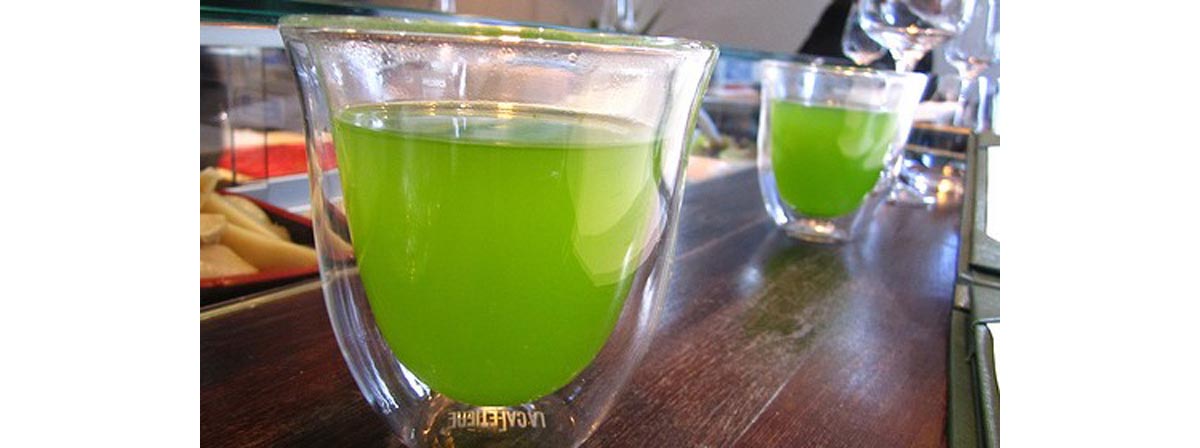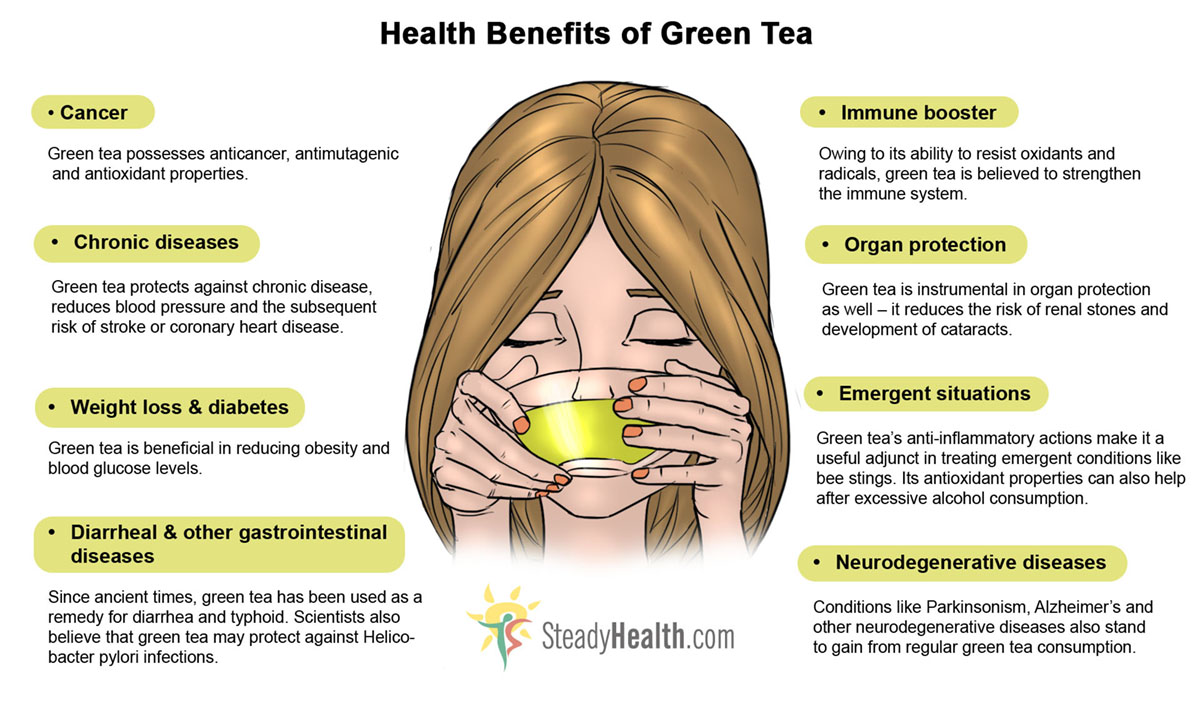Read on, as we take a dig up some research done on green tea – either proving or refuting the health benefits of green tea.
But first, let’s have a look at what green tea is, what the ingredients are and indeed, what makes green tea tick.
What is green tea?
Tea is produced from one source, the Camellia sinensis plant. Tea drinking dates back goes back almost 50 centuries. The health benefits of regular consumption of tea have also been known (or at least suspected) since ancient times.
According to an estimate, the world produces 2.5 million tons of tea each year — and a total of 20 percent of that produce is green tea. Of the different varieties of teas – green, black and Oolong – green tea seems to possess the most health benefits.
What makes green tea tick?
So, what makes green tea tick? Well, the nutritional goodies that are packed in green tea is what makes it tick! Although, since ancient times, humans have known that regular drinking of green tea is good for your health, green tea always had a particularly good reputation. However, research into what makes green tea ‘tick’ has begun in all earnest only in the last 3 decades.
These ‘healthy ingredients’ have the ability to disrupt pathological processes of many diseases and conditions; and there-in lie the health benefits of green tea.
Green tea may also be useful in preventing and treating a variety of bacterial and viral infections.
Researchers are of the opinion that these health benefits of green tea are due to the bioactive compounds present in it. What are these ingredients?
Let’s have a look at some of the things that make up green tea:
- First off, the polyphenol content – flavonoids and flavonols – of green tea are the major player. Of the flavonols, the catechin, EGCG (epigallocatechin-3-gallate) seems to be have the most prominent effects on human health. Additionally, green tea also contains other biologically active catechins like epicatechin, epigallocatechin and epicatechin-3-gallate. Interestingly enough, higher concentrations of catechins are present in green compared to black or Oolong tea.
- Green tea is packed with antioxidants and vitamins. These should be a regular part of our normal diet, and green tea just boosts your nutritional status!
- As if that wasn't enough, you’d also get some amount of amino acids, trace elements and essential minerals from your green tea.
Phew! With so many goodies packed in, no wonder a green tea brew sounds like a magic potion! It's easy to make green tea sound like something that’ll make your health problems disappear in the blink of an eye!
So, is there enough scientific evidence so we can start believing in the magic of green tea? Yes, there seems to be! Here goes…
Health Benefits Of Green Tea And The Evidence In Support
The belief that green tea consumption is beneficial to human health is not a recent idea by any stretch of imagination; scientists have long suspected this association. However, as stated earlier, research into why that is the case has only begun recently. Both animal studies and human clinical data seem to support the beneficial role of regular consumption of green tea.

- Cancer: green tea possesses anticancer, antimutagenic, antioxidant properties; together these help in preventing cancer. Some of the cancers that are affected favorably by green tea are cancer of the mouth, oesophagus, lungs, breast, stomach, colon, small intestine and pancreas. Green tea may also reduce cancer risks posed by environmental agents. Cigarette-smoking induced lung cancer risk is also affected favorably, as shown by Shim et al.
- Chronic diseases: Human clinical trials have concluded that green tea (and black and Oolong tea), owing to its polyphenol and antioxidant content, may provide protection against chronic disease; reduce blood pressure and the subsequent risk of stroke or coronary heart disease. It also shown to be beneficial in reducing obesity and blood glucose levels. Green tea catechins have anti-diabetic effects due to its ‘insulin-like’ and ‘insulin-enhancing’ activities. Also, animal studies have shown that green tea catechins may reduce blood triglyceride levels as well, making it a good choice for people who have high cholesterol.
- Diarrheal and other gastrointestinal diseases: Since ancient times, green tea has been used as a remedy in cases of diarrhea and typhoid; recent research suggests that the ancients were right to use the substance in this way. Scientists also believe that green tea may be effective in resisting Helicobacter pylori infection in humans.
- Immune booster: Owing to its ability to resist oxidant and radicals, green tea is believed to strengthen immunity system
- Organ protection: Green tea is instrumental in organ protection as well – reduces the risk of renal stones and development of cataracts
- Emergent situations: anti-inflammatory actions green tea make it a useful adjunct in treating emergent conditions like bee stings. Acute alcoholic intoxication benefits due to the antioxidant action of green tea
Such phenomenal effectiveness in a number of seemingly unrelated conditions makes green tea a ‘hot property’. It shouldn't come as a surprise that green tea or its ingredients make their way into numerous supplements, health foods, pharmaceutical products and cosmetics.
Take home message
Green tea – on account of the nutritional goodies it contains – seems to able to resist a number of seemingly unrelated pathological conditions. In addition to anecdotal evidence spanning thousands of years, recent research too provides ample proof of the role of green tea in optimizing health.
So, pick up your concoction of freshly brewed green tea and drink away to glory!
- Anderson, R. A. & Polansky, M. M. (2002). Tea enhances insulin activity. J Agric.Food Chem., 50, 7182-7186.
- Cabrera, C., Artacho, R., & Gimenez, R. (2006). Beneficial effects of green tea--a review. J Am Coll.Nutr., 25, 79-99.
- Chacko, S. M., Thambi, P. T., Kuttan, R., & Nishigaki, I. (2010). Beneficial effects of green tea: a literature review. Chin Med, 5, 13.
- Dona, M., Dell'Aica, I., Calabrese, F., Benelli, R., Morini, M., Albini, A. et al. (2003). Neutrophil restraint by green tea: inhibition of inflammation, associated angiogenesis, and pulmonary fibrosis. J Immunol., 170, 4335-4341.
- Dvorakova, K., Dorr, R. T., Valcic, S., Timmermann, B., & Alberts, D. S. (1999). Pharmacokinetics of the green tea derivative, EGCG, by the topical route of administration in mouse and human skin. Cancer Chemother.Pharmacol., 43, 331-335.
- Haqqi, T. M., Anthony, D. D., Gupta, S., Ahmad, N., Lee, M. S., Kumar, G. K. et al. (1999). Prevention of collagen-induced arthritis in mice by a polyphenolic fraction from green tea. Proc.Natl.Acad.Sci.U.S.A, 96, 4524-4529.
- Ishizuk, H., Eguchi, H., Oda, T., Ogawa, S., Nakagawa, K., Honjo, S. et al. (2003). Relation of coffee, green tea, and caffeine intake to gallstone disease in middle-aged Japanese men. Eur J Epidemiol., 18, 401-405.
- Iso, H., Date, C., Wakai, K., Fukui, M., & Tamakoshi, A. (2006). The relationship between green tea and total caffeine intake and risk for self-reported type 2 diabetes among Japanese adults. Ann Intern.Med, 144, 554-562.
- Japanese Green Tea Online.com. (2013). Japanese Green Tea Online.com. Ref Type: Online Source
- Kavanagh, K. T., Hafer, L. J., Kim, D. W., Mann, K. K., Sherr, D. H., Rogers, A. E. et al. (2001). Green tea extracts decrease carcinogen-induced mammary tumor burden in rats and rate of breast cancer cell proliferation in culture. J Cell Biochem., 82, 387-398.
- Khan, N. & Mukhtar, H. (2007). Tea polyphenols for health promotion. Life Sci., 81, 519-533.
- Koo, M. W. & Cho, C. H. (2004). Pharmacological effects of green tea on the gastrointestinal system. Eur J Pharmacol., 500, 177-185.
- Lu, H., Meng, X., Li, C., Sang, S., Patten, C., Sheng, S. et al. (2003). Glucuronides of tea catechins: enzymology of biosynthesis and biological activities. Drug Metab Dispos., 31, 452-461.
- McKay, D. L. & Blumberg, J. B. (2002). The role of tea in human health: an update. J Am Coll.Nutr., 21, 1-13.
- Mukhtar, H., Wang, Z. Y., Katiyar, S. K., & Agarwal, R. (1992). Tea components: antimutagenic and anticarcinogenic effects. Prev.Med, 21, 351-360.
- Pan, T., Fei, J., Zhou, X., Jankovic, J., & Le, W. (2003). Effects of green tea polyphenols on dopamine uptake and on MPP+ -induced dopamine neuron injury. Life Sci., 72, 1073-1083.
- Sano, M., Tabata, M., Suzuki, M., Degawa, M., Miyase, T., & Maeda-Yamamoto, M. (2001). Simultaneous determination of twelve tea catechins by high-performance liquid chromatography with electrochemical detection. Analyst, 126, 816-820.
- Sato, T. & Miyata, G. (2000). The nutraceutical benefit, part I: green tea. Nutrition, 16, 315-317.
- Shim, J. S., Kang, M. H., Kim, Y. H., Roh, J. K., Roberts, C., & Lee, I. P. (1995). Chemopreventive effect of green tea (Camellia sinensis) among cigarette smokers. Cancer Epidemiol.Biomarkers Prev., 4, 387-391.
- Skrzydlewska, E., Ostrowska, J., Stankiewicz, A., & Farbiszewski, R. (2002). Green tea as a potent antioxidant in alcohol intoxication. Addict.Biol., 7, 307-314.
- Sudano, R. A., Blanco, A. R., Giuliano, F., Rusciano, D., & Enea, V. (2004). Epigallocatechin-gallate enhances the activity of tetracycline in staphylococci by inhibiting its efflux from bacterial cells. Antimicrob.Agents Chemother., 48, 1968-1973.
- Sueoka, N., Suganuma, M., Sueoka, E., Okabe, S., Matsuyama, S., Imai, K. et al. (2001). A new function of green tea: prevention of lifestyle-related diseases. Ann N Y.Acad.Sci., 928, 274-280.
- Takabayashi, F., Harada, N., Yamada, M., Murohisa, B., & Oguni, I. (2004). Inhibitory effect of green tea catechins in combination with sucralfate on Helicobacter pylori infection in Mongolian gerbils. J Gastroenterol., 39, 61-63.
- Tsuneki, H., Ishizuka, M., Terasawa, M., Wu, J. B., Sasaoka, T., & Kimura, I. (2004). Effect of green tea on blood glucose levels and serum proteomic patterns in diabetic (db/db) mice and on glucose metabolism in healthy humans. BMC Pharmacol., 4, 18.
- Waltner-Law, M. E., Wang, X. L., Law, B. K., Hall, R. K., Nawano, M., & Granner, D. K. (2002). Epigallocatechin gallate, a constituent of green tea, represses hepatic glucose production. J Biol.Chem., 277, 34933-34940.
- Weber, J. M., Ruzindana-Umunyana, A., Imbeault, L., & Sircar, S. (2003). Inhibition of adenovirus infection and adenain by green tea catechins. Antiviral Res., 58, 167-173.
- Weisburger, J. H. (2000). Approaches for chronic disease prevention based on current understanding of underlying mechanisms. Am J Clin Nutr., 71, 1710S-1714S.
- Wolfram, S., Raederstorff, D., Preller, M., Wang, Y., Teixeira, S. R., Riegger, C. et al. (2006). Epigallocatechin gallate supplementation alleviates diabetes in rodents. J Nutr., 136, 2512-2518.
- Wu, C. H., Lu, F. H., Chang, C. S., Chang, T. C., Wang, R. H., & Chang, C. J. (2003). Relationship among habitual tea consumption, percent body fat, and body fat distribution. Obes Res., 11, 1088-1095.
- Wu, L. Y., Juan, C. C., Ho, L. T., Hsu, Y. P., & Hwang, L. S. (2004). Effect of green tea supplementation on insulin sensitivity in Sprague-Dawley rats. J Agric.Food Chem., 52, 643-648.
- Yee, Y. K., Koo, M. W., & Szeto, M. L. (2002). Chinese tea consumption and lower risk of Helicobacter infection. J Gastroenterol.Hepatol., 17, 552-555.
- Zaveri, N. T. (2006). Green tea and its polyphenolic catechins: medicinal uses in cancer and noncancer applications. Life Sci., 78, 2073-2080.
- Mindmap by steadyhealth.com
- Photo courtesy of Leon Brocard by Flickr : www.flickr.com/photos/acme/6325310648/


